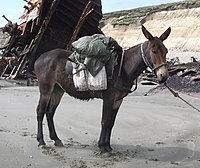
Photo from wikipedia
Diploid Alnus glutinosa s. str. and autotetraploid A. rohlenae form a narrow hybrid zone in a study area in southern Serbia, which results in triploid hybrid formation. The vast majority… Click to show full abstract
Diploid Alnus glutinosa s. str. and autotetraploid A. rohlenae form a narrow hybrid zone in a study area in southern Serbia, which results in triploid hybrid formation. The vast majority of previous studies have been focused on studies of maternal plants, but the offspring resulting from their crossing have not been much studied. Here, we use the variability of microsatellites and chloroplast DNA between these species and their putative hybrids to create an overall picture of the development of the hybrid zone and its predicted type. To elucidate the gene transfer within both species, the origins of individual ploidies and especially the role of triploid hybrids, a germination experiment was carried out linked with a flow cytometry study of the resulting seedlings. The tension zone model seems to offer the most adequate explanation of our observations, with selection against triploid hybrids and the spatial positioning of the hybrid zone. Despite selection against them, the triploid hybrids play an important role in the exchange of genes between the two species and therefore serve as a bridge for introgression. The presence of fertile triploids is essential for enriching the haplotype diversity between these species and for the development of new genetic lineages.
Journal Title: Genes
Year Published: 2020
Link to full text (if available)
Share on Social Media: Sign Up to like & get
recommendations!